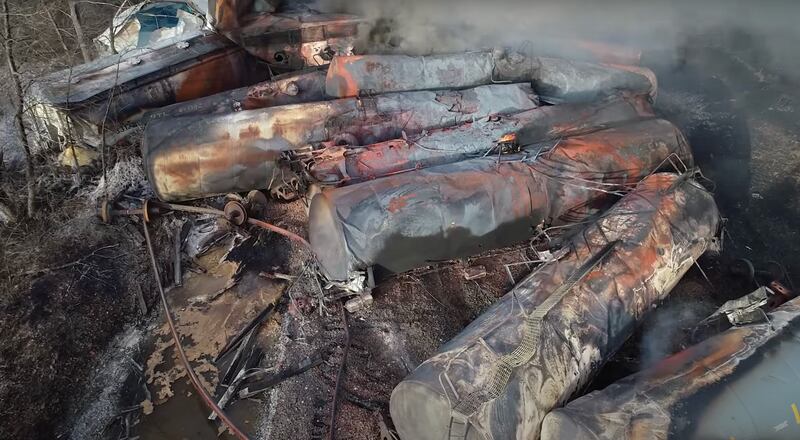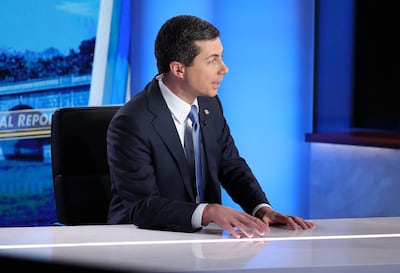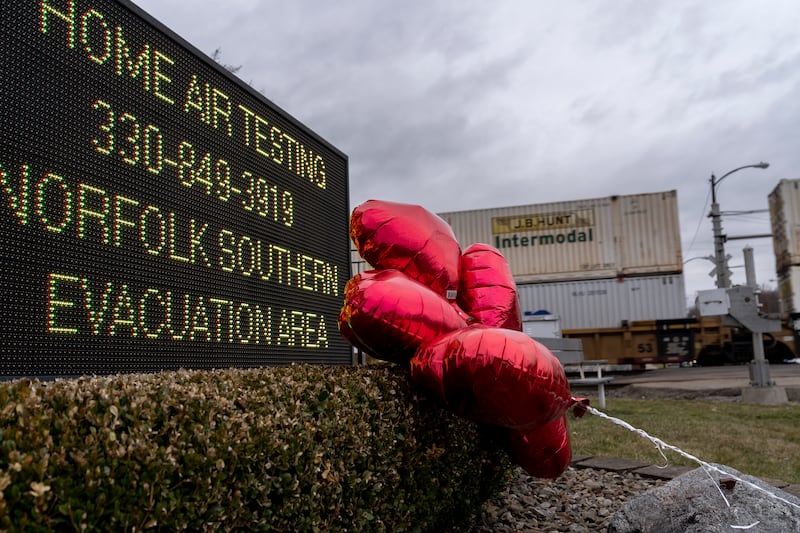Meranda Cope could never hear the thrum of an approaching freight train. She could see railroad tracks from her kitchen window, could even feel her home vibrate when engines drew near, yet the sound always managed to escape her. She’d learned to tune it out after decades of living in a town on the Ohio-Pennsylvania border, where she swears locomotives roll through in what feel like five-minute increments. So on the first Friday night of February 2023, as a Norfolk Southern train inched its way into East Palestine, Cope didn’t hear it coming. But she did hear it crash.
One big, mysterious boom after another. Cope, 30, heard them as she sat beside her husband in their living room, sewing a new batch of bibs for their son-to-be as they watched “Point Break” on TV. She sought answers through a nearby window and noticed a faint glow hovering above the tracks. In a matter of seconds, the glow metastasized to a wall of flames two stories tall. The inferno backlit the silhouettes of wintering trees, it bleached the otherwise inky night an ominous shade of ochre, it pumped plumes of smoke skyward. The train had derailed and its tank cars lay burning. Eleven contained hazardous chemicals that, once ignited, released an acrid metallic odor. Cope, who was seven months pregnant and a brain cancer survivor, chose to flee that night with her husband. “If I remember correctly, these chemicals can cause cancers,” she says. “I’ve already been through it once, I really didn’t want to go through it again.” They sought temporary refuge with family who lived further from the railroad. Though they’d later learn of the disaster’s formidable reach and staying power.

What made the Norfolk Southern train derailment truly unprecedented was not the release of toxic chemicals nor the dramatic blaze. It was the national attention. The spectacle resulted in visits from former President Donald Trump and Department of Transportation Secretary Pete Buttigieg. It became the impetus for proposed bipartisan legislation, labor union demands, even the subject of culture wars as politicians reduced the event to an opportunity for optics. (President Joe Biden, in particular, received flack for not visiting the site.) Even before the crash, transportation infrastructure was becoming an issue fewer and fewer Americans could ignore. Last year, the number of canceled flights around the country reached its highest rate in nearly a decade, barring peak pandemic 2020; supply chain crises — worsened by stalled ships and trucks — had made finding anything from baby formula to fertilizer arduous over the last couple of years. The American Road and Transportation Builders Association recently reported that some 80,000 bridges are in need of replacement, alongside the hundreds of thousands in need of repair. Problems which have existed for decades but are now placed under a microscope for all to see.
The derailment served as just one reminder that frailties in our transportation system can prompt more than detours or inconvenience. They can prompt toxic mushroom clouds, uproot families and, at a minimum, induce fear. The fire in East Palestine lasted several hours and its fumes posed risk of skin burns, serious lung damage and even a “grave danger of death” to anyone who lingered within a mile of the site. Some 43,000 aquatic animals in nearby streams are estimated to have perished in the aftermath. Residents were still reporting rashes, headaches and nausea months later. Many remain traumatized. Including Cope. Once blissfully impervious to the roar of incoming trains, she now not only hears them, she dreads their constant sound. “It’s hard to stay sane when all you hear is a train go by all the time,” she says. “It’s just a continuous feeling over and over again. It’s literally PTSD.”
While there were no direct deaths or injuries, policymakers across political aisles continue to spew a flurry of blame in the disaster’s wake. Most of which falls on Pete Buttigieg’s desk. Prior to his tenure, the role of transportation secretary could have been characterized as low-profile. The department appeared as a sort of governmental phantom limb that operated outside of view. Most Americans didn’t seem to feel one way or another about the agency. Pew Research Center conducted a survey in 2015 to gauge public perception of federal bureaus and branches — the Department of Defense, Department of Justice, Department of Education, and so forth — and the Department of Transportation wasn’t even deemed worth mentioning in the poll.
But Buttigieg, a 2020 Democratic presidential candidate and former Midwestern mayor, has brought with him an unfamiliar limelight to the secretary’s office, one that elucidates matters in even the smallest, most overlooked corners of rural America. Though his high profile also means it’s plainly obvious when transportation infrastructure falls short. And with all of the department’s many weaknesses — some new, some decades old — it raises the question: Can a former small-town mayor, in his first job on the national stage, mend a system this broken?
A recent report includes examples of some $1 billion in unsupported or improper payments across several of the transportation department’s operational agencies in just the last few years.
A sleek wooden podium sat on the side of a road in rural Illinois on the last day of July. Behind it, amid power lines stretched overhead and freshly mowed grass, stood a dark-suited Buttigieg, leaning into a microphone and squinting in the sun. He had arrived in the town of Savoy to announce the creation of an overpass that promised to eliminate a railroad crossing and to decongest local traffic.
When Buttigieg wrapped up his prepared statement and motioned for questions — train tracks looming behind him — the first query came as no surprise. Someone asked about the derailment in East Palestine and how railroad companies have since responded. After all, the same train that put East Palestine in the news six months earlier had passed through central Illinois just the day before its ruin in Ohio. The residents in Savoy felt wary of that coincidence, of its implication. So the secretary offered a classic, middle-of-the-road Buttigieg response. “Look, there needs to be a deep overhaul in terms of safety culture across this country,” he said. “They’ve taken some steps, but we can’t say mission accomplished.”

It was emblematic of the way Buttigieg navigates most of his public appearances. Of which there are many. Within a month of the Illinois trip, he traveled to Texas to cut the ribbon on a port terminal expansion project; he visited his home state of Indiana to sit on an airport shuttle and discuss cargo; he boarded a ferry in Alaska to meet with tribal and government leaders about a new route on the state’s marine highway. Prior to his cabinet confirmation, Buttigieg could be found on talk shows like “The View” and “The Tonight Show” — putting his Midwestern charm on display as often as possible. He’s been a repeated talking head on Fox News, crossing partisan lines that typically deter other Democrats in the Biden administration. He’s even fired back on live TV against calls for his resignation that were sounded by Republican Florida Sen. Marco Rubio following the Ohio derailment. Back in 2020, during the last presidential primary, that knack for public speaking had helped him transcend, however briefly, the label of longshot candidate and enter the upper echelon of Dem hopefuls, and fueled comparisons between Buttigieg and former President Barack Obama, especially given their talk of unity. And it now contributes to his status as perhaps the most well-known and visible secretary of transportation to ever possess the title. But with that unparalleled visibility comes decades worth of postponed blame and baggage.
When I talked to Buttigieg this summer — amid his harried schedule — he told me that most of the department’s impediments are legacies of deregulation efforts by both Democratic and Republican administrations. “We’ve inherited the consequences of 40 plus years of disinvestment in American infrastructure,” he said.
The Department of Transportation formed in 1967 when then-President Lyndon B. Johnson called for an agency “to untangle, to coordinate, and to build the national transportation system … that America is deserving of.” And though Johnson tasked the department to rid the nation’s corridors of prevalent safety abuses, traffic imbroglios and archaic equipment, he stressed that free enterprise should remain a central goal. The Staggers Rail Act and Airline Deregulation Act of the ’70s and ’80s are examples of that foundational emphasis on enterprise in practice. The laws allowed railroad and airline companies to determine their own rates and terms of service, which in turn produced meteoric industry growth and more affordable services for consumers. “This is a legacy of deregulation, which has resulted in hugely positive benefits for the … public,” says one of Buttigieg’s predecessors, Steven Bradbury, acting secretary of transportation during the Trump administration. “I mean, air service is much more efficient, it’s a much lower cost now than it was in the past under regulation.”

But a residual effect of that growth, as Buttigieg has pointed out, is the genesis of consolidated power in the clutches of the few. A small handful of companies swell, Buttigieg maintains, and dominate their sectors, quashing competition by cutting corners. “You see that everywhere from the railroad industry’s approach to radically reducing the number of people working on railroads, to the airline industry using early retirements to shed pilots during Covid,” he told me. These devolutions are symptoms brought on by a long-standing ethos, but they appear as fresh wounds on the present administration. Especially when the figure in charge of steering relevant policy is, for the first time, a household name.
Buttigieg has publicly pushed for solutions since the East Palestine derailment, namely in voicing his support for the bipartisan Railway Safety Act. The bill, presented weeks after the train disaster, would require railroads to provide emergency responders notice of any approaching freight trains in possession of hazardous materials. It would also impose requirements like train length and weight specifications, as well as a two-person minimum crew. That latter point has been debated for ages, including last year when a proposition pushed for the same rule. Collective bargaining agreements with railroad companies have shrunk crew staffing requirements for freight trains from five to three to two people over the years, then down to the current rule that allows trains — sometimes miles long with tens of thousands of tons of weight in tow — to be controlled by a single person.
Federal Rail Administration data reveals an average of three trains derail every day in the United States, as many as half of which may carry hazardous materials. It’s estimated that the longer and heavier the train, the more it could risk derailment; and the fewer people around, the less hands to assist in the event of disaster. For context, the train that crumbled near Meranda Cope’s home in East Palestine had three crew members on board — by most measures, enough to operate the train safely — and still succumbed to its fiery fate. With bipartisan demand for safety reforms at a peak, something as seemingly minute and immediately actionable as increasing the number of onboard employees by a single person appeared surefire. Even Rubio, the same Rubio who argued for Buttigieg’s resignation, was on board with the idea. But the bill began losing support in Congress just as railroad lobbyists spent millions of dollars in Washington. “You can’t overlook the power of the railroad lobby, that’s just an unfortunate truth. They spend a lot of money, a lot of time, a lot of energy influencing people that have the ability to enforce rules and regulations,” says Jared Cassity, a national legislative director and chief of safety for SMART-Transportation Division, the largest rail union in the country. “The fact is, the railroads don’t want to be regulated. … They want to self-regulate. And unfortunately, that got us to where we are today.”

Of all sectors in the United States, transportation ranks sixth for funneling the most funds through lobbyists to control regulatory outcomes. It’s a familiar method of asserting control in Washington, one that is not new nor surprising. But if even a secretary with notable visibility and a record of communicating across political chasms is unable to assert control over bipartisan policy — policy that materializes just as nationwide demand for regulation reaches an unusual crest — it paints a feeble portrait of the department as a whole. I asked Buttigieg about this, about his forecast for proposed action in the fading media blitz of East Palestine. He lamented the resistance to the Railway Safety Act, to harsher fines for safety violations and mandating that railroads implement a confidential whistleblower program for employees to report safety concerns. “I think the jury’s still out,” he said, “on whether (the railroad companies are) going to deliver.”
An average of three trains derail every day in the United States, as many as half of which carry hazardous materials.
Back when he was known simply as “Mayor Pete,” leading South Bend, Indiana, Buttigieg pushed for an initiative dubbed “Smart Streets” practically on his first day in office in 2012. The measure entailed a $25 million overhaul of the city’s downtown. His vision included eight miles of roads converted from one- to two-way traffic, added bike lanes, street parking, greenery — a litany of embellishments to prompt a metamorphosis. He’d been convinced, even amid incessant doubt and criticism, that refurbished transportation corridors could breathe life back into an area that had largely withered to a ghost town. He cut the ceremonial red ribbon to celebrate the project’s groundbreaking five years later.
This early foray into infrastructure and the project’s resulting success followed Buttigieg. It even influenced Biden’s decision to tap him as a candidate for transportation secretary. But working within municipal government and leading a federal department are not quite the same. Especially when the federal department in question operates through 11 individual administrations, each with their own managerial tiers. Among those administrations and bureaus are the Federal Aviation Administration, Federal Highway Administration, Federal Railroad Administration and Federal Transit Administration. It’s a bureaucracy of behemoth proportions, one with some 55,000 employees under its umbrella, and one man at its helm.
As the smoke began to clear in East Palestine, the actions Buttigieg could complete on his own from the top rung of the departmental ladder were limited. He met with union leaders, implemented biannual safety training for Federal Railroad Administration employees, issued ceaseless advisories and bulletins focused on operational safety. But the task with the most heft, and likely the most chance of ensuring reform, had already been set in motion two years earlier, when Biden announced the Infrastructure Investment and Jobs Act. Passed in 2021, the act introduces $1.2 trillion for transportation and infrastructure. It’s the single largest investment in public transit and one of the most substantial pieces of news for American transportation since President Dwight D. Eisenhower created the Interstate Highway System. Much of the finances, though, are still in the process of being parceled out. And even with its size and ample dollars, the department doesn’t operate as efficiently as it’s perceived to. In fact, if anything, its breadth means there’s plenty of space for resources to fall through the cracks.

Ironically, the funding itself poses an issue due to staffing shortages. More than 1,000 employees will need to be hired in order to implement the investment bill and roll out funding, according to the Department of Transportation’s Office of Inspector General, which released a report last November on the department’s top management challenges for 2023. Insufficient staffing heightens the risk of mishandled funds, a recurring problem, per the report. Some $1 billion in unsupported or improper payments occurred throughout the department in just the last few years.
Staff shortages also endanger operational safety and competency. “These dollars, these positions, these jobs really matter,” Buttigieg told me. “We’re talking about impacting things from the training of air traffic controllers to the work done by consumer protection personnel.” Another audit from June revealed more than three-quarters of the administration’s most critical facilities are understaffed, posing “a risk to the continuity of air traffic operations.” The lack of personnel has become a direct source of fault for airline delays and cancellations. It’s indicative of a pandemic era problem that lingers even after $54 billion in taxpayer dollars went toward sustaining the airline industry through Covid.
“The delay rate stayed largely the same pre- and post-pandemic, but what you really see is an increase in cancellations, specifically airline caused cancellations,” says Heather Krause, director of the Government Accountability Office’s physical infrastructure team. She’s one of the organization’s experts on civil aviation issues. Added operational strain caused by a lack of pilots and crew members, Krause says, delays the administration’s ability to hire and train new staff members, perpetuating a vicious cycle.
But the gridlock doesn’t stop there. Permitting processes, too, impede efficiency. “The U.S. is actually the hardest country in the world to build infrastructure because it has a more cumbersome permitting process, even if compared to other developed countries,” says Loren Smith, who served as the Department of Transportation’s deputy assistant secretary of policy during the Trump administration. Merely obtaining the federal permits necessary to pursue infrastructure projects takes four and a half years on average — more than five years for public transit improvements and more than seven for roads or bridges. These averages don’t include the construction time thereafter. So even with a historic level of funding available, even if staffing shortages could be solved overnight, that money can’t move. At least not fast enough.
Yet all these factors — as key as they are in diagnosing what ails the Department of Transportation — get overshadowed in the eyes of the public. At least while the fallout in East Palestine continues to burn bright.

The National Transportation Safety Board launched a special investigation to uncover the derailment’s direct cause. Thousands of pages of documents purport a single wheel bearing on the 149-car train overheated, fell off and ostensibly caused the domino effect. The investigation has yet to conclude, but chairwoman Jennifer Homendy has already announced the fiasco was “100% preventable.” But as some of Buttigieg’s attempts at regulation have proven, the steps necessary for prevention face roadblocks.
No other transportation secretary has proven as distinguishable as Buttigieg. While it’s possible that a less high-profile successor might evade this level of recognizability and scrutiny, the lasting legacy of Buttigieg’s tenure seems likely to be that people will remain more acutely aware of the massive dysfunction within our transportation infrastructure. There’s almost certain to be an influx of Americans with newfound interest and skepticism into how government agencies should and do operate. Meranda Cope might be one of them.
Neither Cope nor her family ever returned to their home within view of the railroad. Her doctor advised her against it. She and her husband now live in her mother’s home until they can afford to put down roots of their own, ideally roots more permanent than before. And with a healthy new infant she calls her miracle baby, she’ll gladly wait as long as it takes to find what she’s looking for. She’s not taking any chances.
This story appears in the November issue of Deseret Magazine. Learn more about how to subscribe.


